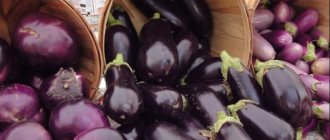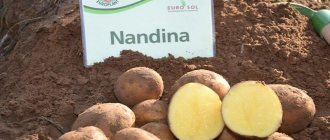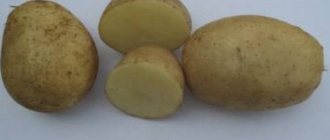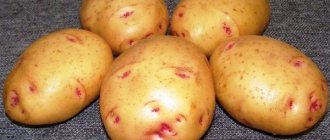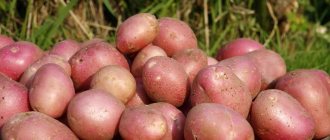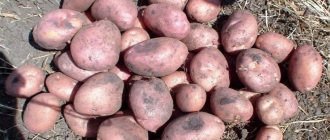Potato variety Assol
Potato Assol is an achievement of domestic selection and belongs to the population varieties. Gives a harvest in any agroclimatic zone. Due to the high yield of marketable products and early ripening, it is in great demand among potato growers and gardeners. The originator is SeDeK.
The plant has erect, slightly spreading bushes 70 - 80 cm high. The foliage is good. Leaves are medium sized, green. Flowers with a white corolla. The tubers have a beautiful elongated oval shape, aligned. The peel is smooth, light yellow. The eyes are shallow and superficial. The pulp is creamy and very tasty.
Our hero has the following characteristics:
- from the moment of full germination to harvest, 55 - 65 days pass, therefore it is classified as early ripening;
- due to early ripening, it is not affected by late blight. The originators also indicate resistance to nematodes and viral diseases;
- plastic, perfectly adapts to any unfavorable conditions, especially valued for its cold resistance;
- The potato yield is excellent. In 2007, the crop showed a record yield - 3460 g per plant, while another well-known variety, Empress, was inferior in this indicator - 3200 g per bush. On average, one nest contains up to 15 tubers, weighing about 110 grams or more;
- does not lose its taste during storage;
- purpose - table, that is, the vegetable is suitable for all types of culinary processing.
A special feature of Assol is that the crop can propagate generatively, that is, it can be grown from seeds. This technique makes it possible to obtain super-elite tubers that will be absolutely free from diseases and provide high yields for at least five years.
The seedless method is used mainly in the south. Sowing is carried out with pre-soaked and hatched seeds in the second half of April. When sown directly, the variety produces 700 g of potato sets.
The most popular, which has many advantages, is the seedling method. Sowing of seedlings is carried out in the first ten days of April. In a bright place at a temperature of 20 - 25 ° C, friendly shoots will appear in 1.5 or 2 weeks.
Hardened seedlings are planted in the ground in May - June. Replanting should be done in cloudy weather or in the evening so that the plants can adapt and not suffer from the heat. This method allows you to collect up to 866 g of sets from a bush.
From the minitubers planted next year, you will receive super-elite tubers suitable for selecting planting material for the next year.
Agricultural technology is usual for early potatoes. The variety can be grown on any type of soil, but light loamy soils with high moisture permeability are still preferred. During cultivation, it is worth carrying out prevention against the Colorado potato beetle.
The Assol variety probably has no drawbacks. But there are a lot of advantages. The main thing is its unpretentiousness to climatic conditions, which allows this potato to be grown in many regions of the country. Resistance to diseases makes caring for the crop many times easier. And its popularity among housewives is ensured by its excellent taste.
Mid-early and mid-ripening varieties
These varieties are more popular among gardeners. They have good taste. They can be stored for a long time. They produce a large number of tubers.
Agatha
Agatha
Low plant. The potato is yellow outside and inside. The tubers are large - on average 120 g. From one bush you can collect up to 15 pieces. The amount of starch is on average 13%.
Productivity – 25 t/ha. Resistant to many diseases: late blight, cancer, fusarium.
Fun
Fun
Ukrainian variety. Has good taste. Tall. Potatoes weighing up to 120 g. Pink outside, white inside. Starch content – 14%.
High-yielding – up to 40 t/ha. Can be transported over long distances.
Irbitsky
Irbitsky
Variety of Russian selection. Productivity – 25 – 40 t/ha. Not picky about soil. Drought resistant. Resistant to late blight, cancer, nematode.
Lily
Lily
Belarusian variety. Large tubers - up to 200 g. Up to 15 pieces under one bush. Contains up to 17.5% starch. Color – straw. Under favorable conditions, up to 40 t/ha can be harvested.
Doesn't turn black when cooked.
Breeze
Breeze
It was bred by Belarusian breeders. High-yielding – 60 t/ha. Medium height. Tuber weight – up to 120 g. Color – yellow. The flowers are purple. The average amount of starch is 14%.
This type of potato can not only be fried, but even frozen.
Sineglazka
Sineglazka
Does not require maintenance. Stores well. The tuber is white inside, gray outside. High-yielding – 50 t/ha. Starch content – 15%. Resistant to nematode, scab, cancer.
Aurora
Aurora
Tall. Productivity – 21 – 38 t/ha. Tubers are brown. The inside is cream colored. On average, one plant produces 13 pieces. The weight of one is up to 130 g.
The average starch content is 15%. It has excellent gastronomic qualities.
Manifesto
Manifesto
Belarusian variety. Medium height. The flowers are painted lilac. The tuber is pink. The pulp is amber. The weight of one potato reaches up to 145 g.
The average starch content is 13%. Productivity – 16.5 – 34 t/year. Can be stored for up to 6 months. Not crumbly.
Apple tree: description of the 25 best varieties with reviews from gardeners about them
Description of potatoes
Potato Assol is the most popular early variety. The ripening period is 50-70 days, depending on growing conditions and climate zone. Gives a stable increase in yield. Early ripening makes potatoes of this variety resistant to such a dangerous disease as late blight. It has good keeping quality characteristics.
Plant characteristics
- plants are erect, semi-spreading;
- foliage and stem are bright green;
- medium-sized leaves with slightly uneven outer edges;
- the flowers are white.
Characteristics of the fetus
The tubers have an elongated, oval shape. The peel is yellowish in color with a smooth structure. The eyes are small, evenly distributed throughout the tuber.
The pulp is yellow when cut and does not lose color during heat treatment. Used for preparing various culinary delights.
Advantages and disadvantages of Lina root vegetable
Potatoes "Lana" are a medium early variety characterized by high yield. The main advantages of this type of root crop are the following:
- Suitable for both cooking and production of chips. Due to its marketable appearance, this plant variety is very popular in the market;
- The variety is not susceptible to potato canker and the action of microorganisms that contribute to the development of late blight. However, the golden nematode poses a danger to the plant;
- Differs from many other varieties in good taste;
- Has an excellent presentation;
- Frost resistance, drought resistance;
- In addition, this variety does not require special care.
Disadvantages of the variety:
- High starch content – up to 18%;
- The umbilical part is strongly pressed into the tuber.
One of the highest-yielding types of root crops is “Lina” potatoes. The positive characteristics of this variety were compiled by the best specialists in the field of plant growing; the root crop is resistant to droughts and heavy rains. The peculiarity of the root vegetable is that the plant does not require special care, but has an attractive presentation: a smooth surface with small eyes, an oval shape. All fruits are practically the same size.
Advantages and disadvantages
The undoubted advantage of early Assol potatoes is their low susceptibility to late blight and the ability to grow the crop twice a season. High taste characteristics make it suitable for preparing all kinds of dishes and for use in industrial production. The variety adapts perfectly to the climate conditions of any region and is not picky about soil composition.
Assol potatoes are easy to care for and are perfectly preserved throughout the winter without loss of taste. Like all other varieties of nightshade crops, it is subject to attacks by the Colorado potato beetle. This is perhaps the only drawback.
Agricultural technology
Plants need to be looked after
You can increase productivity by following the rules of agricultural technology and providing optimal care. All varieties of potatoes are heat-loving plants, so you need to select an open area. Potatoes should be planted from north to south in order to provide the bushes with the necessary amount of vitamin D, which is produced by the sun's rays.
Assol potatoes respond well to loosening and fertilization. It is important to follow the rules of crop rotation:
- select healthy tubers for planting;
- Do not plant potatoes in the same place for several years in a row.
Soil preparation
The qualitative composition of the soil plays a significant role in the cultivation of root crops. The highest yields are observed on sandy loam soils. They begin to prepare the soil immediately after harvesting the entire crop from the garden. If it is not possible to change the area for planting, green manure plants are planted on it, which include winter crops, flax, and legumes.
In the fall, the site needs to be dug up and organic fertilizers or superphosphates applied. Cultivation is carried out to a depth of 30 cm or more. If there are too many weeds in the area, you can use herbicides. In addition to weeds, they help destroy the larvae of the Colorado potato beetle, which are buried in the soil to a depth of 50 cm in the fall. In the spring, the soil is fertilized and cultivated again. In spring, it is not recommended to use fresh mullein or bird droppings.
Seed preparation
Seeds also begin to be prepared in the fall. During harvesting, sorting is carried out, whole, even root crops are selected for seeds, some are left for food, and the rest for reserve. To ensure good shelf life and protect against rodents, potatoes should be greened. If weather conditions permit, root vegetables are laid out in an open area for 2 days. When it is not possible to leave vegetables outside, they are stored in a well-lit room for 7 days.
In spring, seeds are germinated using any convenient method. Potatoes can be propagated by tubers, seedlings, or collected seeds during the formation of berries on the bushes. Collecting seeds from bushes is quite difficult, and this activity also requires certain breeding knowledge. Propagation by seedlings can increase productivity by 30-40%. To do this, after sprouting the potatoes, the sprouts are removed and planted in boxes.
Landing
Planting depth depends on the soil
The description of the variety makes it possible to understand that the method of planting potatoes is determined depending on the type of soil. The shovel fit is considered universal and most commonly used. The depth of planting seeds on heavy soils is no more than 5 cm, on light soils - 12 cm. Leave 40 cm between holes, 60-70 cm between rows.
Assol potatoes should be planted when the soil warms up to 10 ℃. At the planting stage, you need to apply nitrogen and potassium fertilizers. These are the minerals that plants need for optimal development. To prevent the appearance of pests, place onion peels in each hole. Instead of potassium solutions, you can use wood ash.
High-quality care ensures a good harvest. Caring for potatoes is determined by a whole range of measures. Water the potatoes with Assol as needed. In regions with arid climates, watering is carried out every 10 days, water is poured carefully under the bushes.
Think again...
Like any phenomenon in our world, growing potatoes from seeds has its pros and cons. Therefore, before deciding to take this step, you should once again carefully weigh all the pros and cons related to seed cultivation of your favorite root crop.
Advantages:
- All sold seeds undergo special treatment to preserve their properties over time. Therefore, purchased material has almost 100% protection against various diseases. These include not only viruses and bacteria, but also fungal infections.
- Almost all plants grown from seeds are much more easily adapted to specific environmental conditions, soil type and growing conditions. This may seem strange, however, with tuber cultivation such a picture is not always observed.
- A question of finances. Potato seeds are several times, and sometimes even an order of magnitude, cheaper than tubers or seedlings. This is easily explained, since seeds do not involve any costs for growing and storing seedlings and tubers.
- Seed germination persists for 5-6 seasons, so they can be planted virtually any time. Tubers, naturally, do not have such an advantage. Once you buy them, you can’t wait: they need to be planted or thrown away; As a rule, seed material is not suitable for food.
Flaws:
- it requires a relatively long time; in addition, mistakes in this process are fraught with consequences that will be impossible to correct and everything will have to start all over again;
- in fact, a two-year crop is being grown, that is, for one year you can forget about the potato harvest.
On the other hand, both disadvantages can be said to be artificial, since, despite the length of the process, it is quite simple; only accuracy in performing the necessary procedures is required. As for taking a break from growing potatoes, no one is stopping you from doing parallel cultivation from tubers and from seeds in different areas.
Potato berry with seeds
Growing seeds yourself is not recommended, since it does require the use of very complex and labor-intensive methods. In addition, the process of preparing and rejecting such seeds takes a lot of time. And it is generally not possible to do high-quality antifungal or antiviral treatment at home.
Projects of country houses for 6-10 acres: 120 photos, description and requirements | The most interesting ideas
Diseases and pests
The early potato variety Assol is characterized by high resistance to all kinds of diseases. But, you should not neglect disinfecting the tubers before planting, especially if you plan to plant potatoes twice a season. Preventive spraying with systemic fungicides is also carried out until the end of flowering.
A malicious pest of potato plantings is the Colorado potato beetle. Adult beetles and larvae can remain in the ground all winter. If the females managed to mate in the fall, then in the spring they will begin to lay eggs on young shoots. For the prevention and destruction of the Colorado potato beetle, the following drugs are most often used: Regent, Colorado, Hurricane, Prestige.
If there are not many pests, it is better to collect them manually. In addition, many farmers use a solution from the beetles themselves to spray the bushes. Pests accumulate the poison solanine. Insects are collected in a jar and infused in water for a week, then the resulting liquid is diluted with water 1:1.
Description of the variety
The manufacturer of Assol potato seed material is a well-known and well-established company in the market . An early variety that demonstrates high productivity regardless of weather conditions and climatic zone.
The bushes are erect, semi-spreading. Potato tubers are uniform in shape and size, elongated-oval. The skin of the potato is smooth, light, with superficial eyes. The pulp of the tubers is light yellow, closer to cream color, slightly boiling.
Potato "Assol" has complex resistance to diseases such as late blight and nematode, as well as viral infections. The description of the variety indicates the excellent adaptability of this potato to almost any unfavorable conditions. The ripening period of this early ripening variety varies between 70-90 days.
Why did the Baron variety fail?
I wanted to experiment, and I purchased seeds of the Assol, Baron and Farmer varieties
. I sowed it in March along with tomatoes. The seedlings sprouted perfectly, and in April I planted them in boxes with sawdust.
Since tomatoes dominated the window sills, and my potatoes were content with what they had, part of them died... I planted the rest in the garden in holes every 20 cm and looked after them like the rest.
As a result, Assol did not stand the test, and Baron and Farmer produced tubers the size of a bean to a chicken egg. In 2021, I first planted them all in a box with sawdust. All the roots were intertwined there, and in order to separate them, I had to “wash them out” in a bucket of water.
And, again, they did not use our benefits. In the fall, we collected approximately the same harvest - two buckets each - and tasted it. And now they were already digging along with other varieties, but they weren’t particularly pleased with something: among the Baron there were several rotten tubers, and the Farmer encountered large ones with empty spaces, which never happens with Gala.
So, dear summer residents, if you come across Gala seeds, buy them and try them. After all, for some people both the Baron and the Farmer are good, but here, perhaps, the soil is not the same, or the climate is not suitable. In general, it is better to take tubers, since among the Baron tubers (grown from seeds) there were red eyes, and white, and yellow pulp. Therefore, I still don’t understand what the main characteristics of this variety are.
But I left a little of everyone for the seeds.
Timing and features of planting
“Assol” potatoes should be planted in fertile and light soil, which is heated to +8-10 C. When planting, it is recommended to follow the following agricultural technology requirements:
- it is advisable to fertilize the soil for planting in the fall, improving its qualitative composition with the help of humus;
- For each square meter of planting area, it is recommended to add approximately 10 liters of well-rotted manure;
- if there is acidic soil on the planting site, it is necessary to carry out high-quality liming in the fall;
- for planting in order to obtain a high-quality and high yield, it is recommended to use good varietal seed material;
- potatoes are responsive to the application of fertilizers containing magnesium, nitrogen, potassium, sulfur, phosphorus, iron, magnesium at the planting stage;
- to create planting rows, it is best to use a stretched cord, leaving a distance between rows of 70 cm, and between holes approximately 30 cm;
- You need to add a handful of high-quality humus to the hole, and then lay the tuber with the sprouts facing up.
After planting several rows of potatoes, it is recommended to carefully level the area with a rake. It is very important not to thicken potato plantings, as this can negatively affect the yield and reduce the quality of the resulting crop.
Rules of care
Potatoes of the “Assol” variety show high yields if agricultural techniques are followed and competent, timely care is carried out:
- approximately ten days or two weeks after planting the tubers, weeding should be done, followed by hilling or loosening the row spacing;
- three weeks after emergence, it is recommended to carry out preventive spraying of potato tops against late blight and the Colorado potato beetle;
- if there is an insignificant number of pests such as the Colorado potato beetle on the plantings, it is advisable to replace the use of chemicals with manual collection of parasites;
- during drought, irrigation measures should be carried out, filling the depressions between the rows with water;
- In case of dry soil, watering is carried out at least three times a month using a large amount of water.
Further care of potato plantings consists of several fertilizing with slurry or bird droppings, weeding and timely hilling of plants.
Harvesting is the most labor-intensive job in potato farming. The volume of the harvest and the shelf life of tubers during storage largely depend on the quality of potato harvesting.
Potatoes from seeds. We plant mini tubers. Season 2021 Part 2
Potatoes in boxes under straw
The main problem that needed to be addressed in 2021 was the lack of space for planting mini-tubers. The main planting potatoes took their place in the boxes. In the territories “annexed” to the site, I planted the old “Adretta” (as always, for the last time!))). Well, the children will come...
“Adretta” behind the plot Divided the mini-tubers into 3 parts according to the size of the potatoes, and had difficulty finding places for them. 2 places next to “Adretta”, and the third was artificially poured near an apple tree and 2 gooseberry bushes next to the bathhouse. We have long wanted to add soil in this place. She started hauling the land herself in a wheelbarrow from the little forest where she was looking for potatoes; he and my neighbor always help us out. My husband looked at my activity and took matters into his own hands. But then I realized that I needed somewhere to put the Romanesco cabbage and the early Savoy Nyusha. It seems like they were dividing the seedlings, but there were still a lot left. As a result, I “attached” cabbages, and between them the smallest potato tubers from last year’s seeds.
And Romanesco, and potatoes, and Savoy
I thought that we would eat the cabbage before the “rich” potato harvest was harvested... I thought in vain. “Romanesco” began to turn into “banana” thickets.
Everything has started to grow. There is a lowland here, and it is necessary to raise it, but the hands, as they say, “didn’t reach it.” Behind the “cucumber finder” is a semicircular bed with “Romanesco”, “Nyusha” and the potatoes being tested.
The next part of my story about how I grew potatoes from seeds could well be titled: “The potatoes are tasty, shelf-stable, productive . A well-stored, disease-resistant, rich harvest is very suitable for fattening animals and for commercial purposes, for the market, in our opinion. On one of the farming sites I came across a heated discussion of varieties; they recommend, without hiding, some varieties for themselves, and others for sale. Therefore, the main selection criterion for placement on a kind of “ladder of honor” was the taste of the tubers, since they are grown for the family table.
Potatoes from seeds 2015
March 2021 has arrived. I begin to prepare the potatoes for planting: I take them out of the basement, lay them out in one layer in small plastic boxes with holes (usually such boxes are used for transporting champignons, as well as greens). There are also large, strong ones in hardware stores, but the light penetrates better through the former.
I sprouted the mini-tubers in the same boxes in which I stored them. I place it in a bathhouse for a couple of hours, where the temperature is not higher than 40 degrees. Then I bring it into the house, place the boxes on the table level (not on the floor), covering them with a tulle curtain and pre-spraying them with a solution of the drug HB-101 (1 drop per half liter of water).
In the future, I spray every other week, sometimes even two. I used to sprouted it in 5-liter plastic bottles, cut horizontally at the top (to put the potatoes inside). The tubers germinate well, but problems arise with extracting the sprouted and intertwined roots.
Of course, germinating in large bottles is convenient, compact, and clean. 10 days before planting, I covered it with a dark, light-blocking cloth. All potatoes were planted under straw, except for a few mini-tubers of the Assol variety. It was planted with further hilling using the classical method. Sometimes they complain on the website that poorly threshed grain suddenly sprouts from under the mulch, forgetting that the straw needed is not fresh, but rotten. And in a box, and with such mulch, it’s a pleasure to grow potatoes.
Before planting in the ground, I put the tuber in a mash of 3 liters of warm water, 1/4 cup of sugar or jam, 1/2 pack of “Shine-2”, left for 2 hours. And she immediately laid it out, going a little deeper into the ground, after putting in a handful of mustard cake and a little ash. I see how the land changes every year, it becomes more fertile, but sometimes the wireworm makes itself felt.
Mustard cake from wireworms I plant with cake
I planted the largest mini-tubers one at a time, and the small ones - 2-3 per nest, 40 cm between the tubers. Then she covered it with straw. It rained on the day of planting, so only the next day I shed the mulch with Siyaniem-1. These are seedlings behind the plot.
"Empress"
When mulching, the shoots grow very quickly; when “unhilling,” they still stretch out, so mini-tubers must be planted at a sufficient distance from each other, and the distance between the rows must also be maintained, which is necessary for adult tubers - up to 90 cm.
True, there are varieties with a compact nest, “Ilona”, for example. And “Farmer”, “Empress” and “Assol” scatter stolons over a considerable distance.
All five varieties are early varieties; Ilona takes a little more time to ripen (70-90 days).
Different varieties of potatoes differ in the shape of the tubers. The following forms are accepted for characterization :
- round,
- elongated,
- oval,
- round-oval,
- elongated oval,
- onion,
- barrel-shaped
with small, medium and large eyes.
Differences in tuber color:
- white,
- pink,
- red,
- blue-violet,
- red-violet,
- yellow,
- cream
All five varieties have yellow flesh, which means they contain large amounts of carotene. The starchiness of the tuber is considered decisive for the level of culinary value. The higher the starch content, the tastier the potato, the better it boils. The starch in the tubers can be felt by the “grainy” taste.
The shapes of potato bushes are:
- compact,
- spreading,
- semi-spreading.
According to the position of the stems:
- erect,
- sprawling
- and semi-collapsed.
The height of the stems and their power depend on the humidity of the air and soil, on the lighting, and on the size of the planting material. And most importantly - the quality and composition of the soil. The same variety can give different yields and taste in different climatic zones on different soil types.
That is why we abandoned the following varieties: Veneta, Scarb, Rosara, Nevsky, Red Scarlet, Golubizna, Udacha, Aurora, Zhukovsky, Sudarynya. The taste qualities were not satisfactory first of all, then the yield, the tendency to disease, hence the shelf life. Therefore, last season we treated new varieties with passion. All the small potatoes were eaten in the summer; it is difficult to taste them at a young age. For this reason, the tasting according to the rules was carried out now, in early January.

